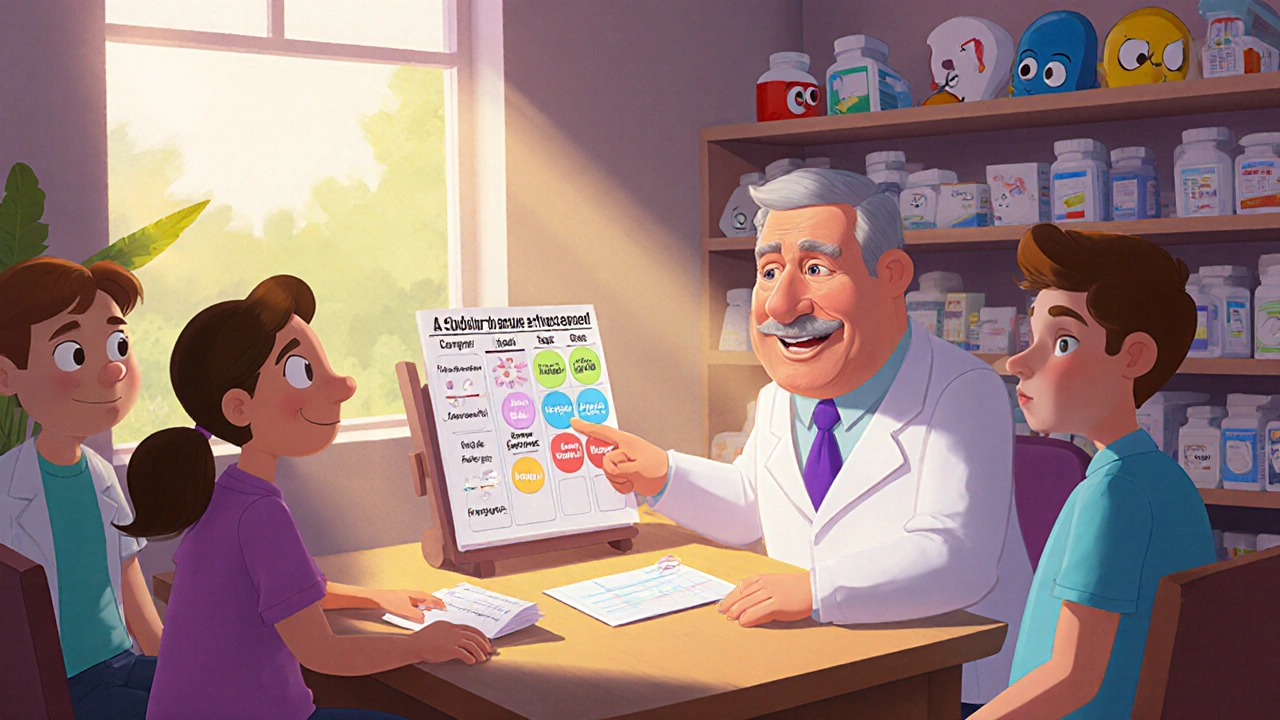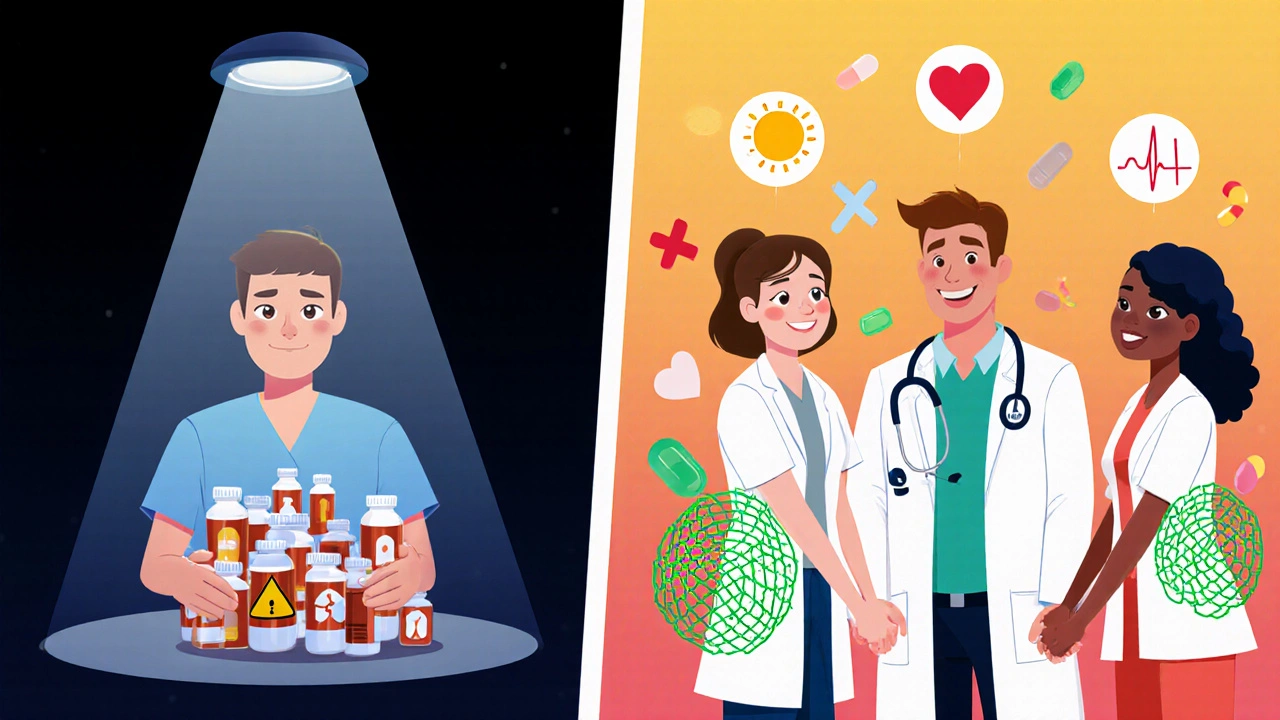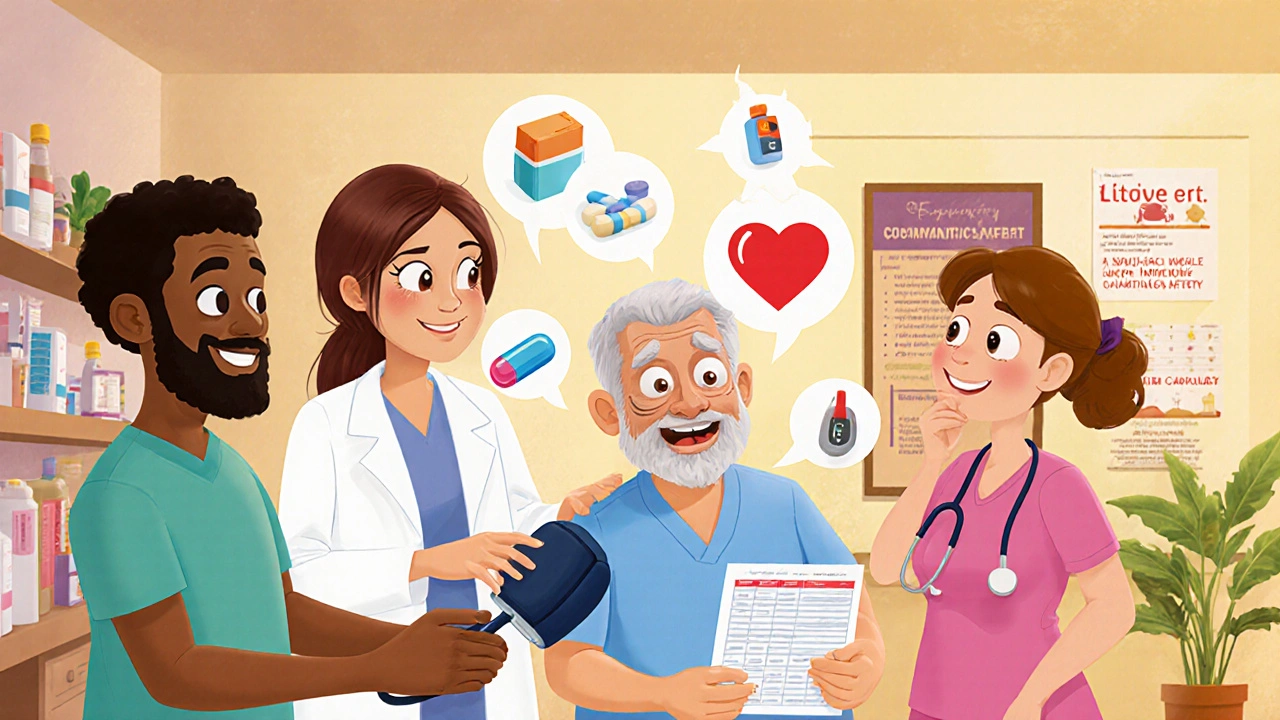Medication Side Effect Checker
Check Your Medications
Results
When you’re managing chronic pain, diabetes, or heart disease, side effects from medications aren’t just annoying-they can be dangerous. A dizziness from a blood pressure drug might lead to a fall. A stomach ache from an antibiotic could make you stop taking it entirely. And if no one’s watching, these problems pile up until you end up back in the hospital. That’s where pharmacist collaboration changes everything.
Why Side Effects Get Missed in Traditional Care
In the old model, you see your doctor for a checkup. They write a prescription. You fill it at the pharmacy. Then you wait until your next appointment-maybe three months later-to talk about how you’re feeling. Meanwhile, you’re juggling five or six meds, each with their own side effects. You might not even realize your fatigue is from a drug interaction, not just aging. Or you’re too embarrassed to mention the diarrhea because you think it’s "just part of the treatment." Studies show that 43% of patients taking five or more medications have at least one dangerous drug interaction. And 50% of people with long-term conditions like diabetes don’t take their meds as prescribed-often because side effects weren’t properly addressed. That’s not patient failure. That’s system failure.The Team That Actually Catches Problems Before They Happen
Picture this: You walk into a community clinic for your diabetes checkup. Your doctor checks your blood sugar. Your nurse updates your vitals. And then your pharmacist joins the room. Not just to hand you a pill bottle-but to ask: "How’s your stomach been? Any tingling in your feet? Are you skipping doses because of the nausea?" This isn’t fantasy. It’s happening in over 41% of U.S. primary care clinics as of 2023. Pharmacists aren’t just dispensers-they’re clinical experts trained to spot hidden risks. They know which drugs clash with each other. They know which side effects are common but rarely reported. And they know how to adjust dosing or suggest alternatives without waiting for a doctor’s visit.How Pharmacists and Doctors Work Together-For Real
It’s not about replacing doctors. It’s about filling the gaps. Doctors diagnose. Pharmacists optimize. Specialists manage complex conditions. And together, they close the safety net. In hospitals, pharmacists join daily rounds. They review every medication order. They flag a drug that could worsen kidney function in an elderly patient. They suggest switching from a pill that causes dizziness to one that doesn’t. In one 2019 study, this kind of teamwork boosted blood pressure control in African-American men from 29% to 94%. That’s not luck. That’s precision. In primary care, pharmacists run medication therapy management (MTM) sessions. These aren’t quick chats. They’re 30-minute deep dives. They map out every pill you take. They check for duplicates. They ask if you’re using OTC painkillers that could interfere with your heart meds. They even call your family to see if you’re swallowing pills correctly. One pharmacist in Wisconsin reduced hospital readmissions by 27% for high-risk patients just by doing weekly follow-ups and adjusting meds before side effects got out of hand.
Real Examples: Side Effects That Got Fixed
Take Maria, 68, with heart failure and arthritis. She was on six meds. She kept falling. Her doctor blamed her age. Her pharmacist found the culprit: a diuretic causing low sodium, combined with an NSAID making her dizzy. They switched her to a safer pain reliever, cut the diuretic dose, and added a potassium supplement. No more falls. No more ER visits. Or James, 52, with type 2 diabetes. He stopped his metformin because of stomach cramps. His doctor assumed he wasn’t compliant. His pharmacist discovered he was taking it on an empty stomach. They switched him to an extended-release version and gave him a simple meal plan. His HbA1c dropped by 1.2% in three months-without adding a single new drug. These aren’t rare cases. They’re the norm in teams that work together.What’s Holding Teams Back?
It’s not lack of evidence. It’s lack of structure. Many doctors still see pharmacists as order-fillers, not partners. Some clinics don’t have the time or tech to integrate them. Only 28 states reimburse Medicaid for pharmacist services. That means many teams can’t afford to pay pharmacists for the time they spend reviewing meds. Electronic records don’t always talk to each other. A pharmacist in a community pharmacy might not see what a hospital doctor just prescribed. A specialist’s notes might not reach the primary care team. That’s how dangerous gaps happen. And then there’s paperwork. One pharmacist on Reddit said she spends 2.5 hours a day just documenting-time that could be spent talking to patients.How to Get This Kind of Care-Even If You’re Not in a Big City
You don’t need to live in a fancy medical center to benefit. Here’s how:- Ask your doctor: "Do you work with a pharmacist on my care?" If not, ask if they can refer you to one.
- Visit a community pharmacy with a medication therapy management program. Many CVS, Walgreens, and independent pharmacies offer this free with insurance.
- Bring a full list of every pill, supplement, and OTC drug you take-even the ones you only use once in a while.
- Ask your pharmacist: "Could any of these be causing my side effects?"
- If you’re on Medicare, ask if you qualify for a free medication review under Part B.

The Future Is Already Here
By 2025, Medicare plans to start paying pharmacists directly for comprehensive medication reviews. That means more teams will form. More patients will get help. More side effects will be caught early. Academic medical centers are already planning to expand pharmacist roles by 92% by 2026. And the data is clear: teams that collaborate reduce hospital readmissions by 23%, cut emergency visits by 16%, and boost patient satisfaction by 18.7%. This isn’t about adding more people to your care. It’s about making sure the right people are talking to each other-before you end up in the ER because a side effect was ignored.What You Can Do Today
Start small. Next time you pick up a new prescription, don’t just walk out. Ask the pharmacist:- "What side effects should I watch for?"
- "Could this interact with anything else I’m taking?"
- "Is there a gentler version if I can’t tolerate this?"
Can pharmacists really change my medications?
In many states, pharmacists can adjust doses, switch medications, or order lab tests under a collaborative practice agreement with a doctor. They can’t prescribe from scratch, but they can make clinical changes to improve safety and reduce side effects-without waiting for a doctor’s appointment. These agreements are now legal in 48 states.
Is this only for people with chronic illnesses?
No. Anyone taking multiple medications-even just two or three-can benefit. Side effects don’t care if you’re 25 or 75. If you’re on blood pressure meds, antidepressants, or painkillers long-term, a pharmacist review can catch hidden risks you didn’t know existed.
Do I need a referral to see a pharmacist for medication review?
Not always. Many community pharmacies offer free medication reviews with no referral needed. Medicare Part B also covers medication therapy management for beneficiaries with multiple chronic conditions. Ask your pharmacist or call your insurance provider.
Why don’t all doctors work with pharmacists?
Some haven’t been trained to see pharmacists as clinical partners. Others work in systems that don’t pay for the time it takes to collaborate. But adoption is growing fast-especially in clinics that get paid for keeping patients healthy, not just for seeing them. The biggest barrier is changing old habits, not lack of evidence.
Are pharmacist-led teams more expensive?
No-they save money. A 2023 analysis found interprofessional teams saved $28.7 billion a year in the U.S. by preventing hospitalizations, reducing medication errors, and improving adherence. Every dollar spent on pharmacist collaboration returns $3-$7 in savings. That’s why major insurers and Medicare are expanding coverage.


Manuel Gonzalez
November 1, 2025 AT 00:03Finally, someone nailed it. I used to think pharmacists just handed out pills like candy. Then my grandma started having dizziness from her blood pressure med, and the pharmacist caught that it was clashing with her OTC fish oil. She switched her meds, no doctor visit needed. Now she’s hiking again. Simple. Effective. Why isn’t this standard everywhere?
Brittney Lopez
November 1, 2025 AT 01:20This is the kind of care we all deserve. I’m a nurse, and I’ve seen firsthand how pharmacists catch things doctors miss because they’re rushing between patients. That 30-minute MTM session? It’s not a luxury-it’s a lifeline. Especially for older folks juggling five meds and too scared to say they’re skipping doses. We need more of this, not less.
Jens Petersen
November 1, 2025 AT 19:49Oh, here we go. Another feel-good narrative dressed up as ‘healthcare innovation.’ Let’s be real: pharmacists are glorified clerks with a PharmD and a 100K student loan. They don’t ‘optimize’-they follow protocols written by pharmaceutical reps. That ‘94% blood pressure control’ stat? Probably cherry-picked from a single clinic with a $2M grant. Meanwhile, real systemic issues like Medicaid underfunding and physician burnout get glossed over like a bad Wikipedia edit. This isn’t collaboration-it’s PR.
Dade Hughston
November 3, 2025 AT 16:34OMG YES I HAD THIS EXACT THING HAPPEN TO ME MY DOCTOR GAVE ME METFORMIN AND I WAS SO SICK I THOUGHT I WAS DYING I STOPPED TAKING IT AND THEN MY BLOOD SUGAR WENT CRAZY AND I GOT A DIAGNOSIS FOR A THING I DIDNT EVEN KNOW I HAD AND THEN I WENT TO THE PHARMACY AND THE PHARMACIST WAS LIKE OH YOU DONT TAKE IT WITH FOOD DO YOU AND I WAS LIKE WHAT AND SHE SAID YEAH YOU’RE SUPPOSED TO TAKE IT WITH A MEAL AND NOW IM FINE AND I CANT BELIEVE NO ONE TOLD ME BEFORE AND WHY ISNT THIS STANDARD AND WHY DO WE STILL HAVE DOCTORS WHO JUST WRITE PAPERWORK AND NEVER TALK TO PEOPLE I MEAN COME ON
Jim Peddle
November 5, 2025 AT 15:00Let’s not pretend this is about patient care. It’s about control. Pharmacists are being positioned as gatekeepers to replace physicians-quietly, incrementally. The data you cite? Funded by pharmacy chains. The ‘collaborative practice agreements’? Legal loopholes pushed by lobbyists. And don’t get me started on Medicare’s new reimbursement model. This isn’t progress. It’s a corporate rebranding of pharmaceutical distribution under the guise of ‘team-based care.’
S Love
November 6, 2025 AT 09:53As someone who grew up in a rural town with one pharmacy and zero specialists, this article hit home. My mom had diabetes and didn’t speak English well. The pharmacist at the corner store-Mr. Nguyen-sat with her every week. He drew pictures of her meds, called her daughter in California, and even translated the side effect sheets. He didn’t have a fancy title. He just cared. That’s the real magic here-not the stats, not the policy changes. It’s the human connection. We need more Mr. Nguyens, not fewer.
Pritesh Mehta
November 7, 2025 AT 05:22How can you speak of healthcare collaboration while ignoring the fundamental truth? The American system is a corporate theater. You praise pharmacists, yet ignore that 70% of drug patents are held by U.S. conglomerates who profit from side effects because they create demand for more pills. The pharmacist is not a hero-he is a cog in the machine that sells you medicine to fix the medicine. True healing lies not in more pharmacists, but in dismantling the profit-driven model that turns human bodies into balance sheets. Your ‘team’ is still selling pills. That’s not collaboration. That’s capitalism in a white coat.
John Concepcion
November 8, 2025 AT 02:45Lol you people act like pharmacists are wizards. I’ve seen them mess up my prescription THREE times. One time they gave me my neighbor’s blood thinner. Another time they didn’t even check if I was on warfarin. And now you want me to trust them with my meds? Meanwhile, my doctor spends 20 minutes asking me how I’m really doing. Who’s the real professional here? The guy who counts pills or the guy who actually listens?
Caitlin Stewart
November 9, 2025 AT 01:23I work with a pharmacist in my clinic and she’s the quiet hero. She doesn’t talk much, but she notices everything. The elderly man who forgot his insulin because his hands shook. The teen on antidepressants who was using ibuprofen daily-masked depression symptoms. She doesn’t need to be loud to be powerful. She just shows up, reads the charts, and speaks up when it matters. That’s the kind of care that saves lives. Quietly. Consistently. Without fanfare.
Emmalee Amthor
November 9, 2025 AT 17:28imagine if we treated the body like a garden instead of a machine. side effects aren’t bugs-they’re signals. the pharmacist isn’t just fixing dosages-they’re listening to the body’s whisper before it screams. we’ve been taught to silence discomfort, not understand it. what if we stopped seeing meds as fixes and started seeing them as conversations? maybe the real innovation isn’t the team-it’s the willingness to slow down, to pay attention, to honor the body’s language. we’re not broken. we’re being misunderstood.
Leslie Schnack
November 10, 2025 AT 02:29Can someone clarify how many states allow pharmacists to adjust prescriptions without a doctor’s signature? I’ve heard conflicting numbers. Also, does this vary by drug class? Like, can they change a beta-blocker but not an opioid? Just trying to understand the legal boundaries before I bring this up with my own provider.
Manuel Gonzalez
November 12, 2025 AT 01:23Good question. It’s 48 states for dose adjustments under collaborative agreements, but opioids and controlled substances are still locked down tight. Most states won’t let them touch Schedule II meds without direct physician oversight. But for blood pressure, diabetes, anticoagulants? Yeah, they’ve got pretty broad authority if the doctor signs off on the protocol. It’s not full prescribing, but it’s way more than most people realize.